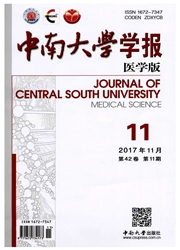

 中文摘要:
中文摘要:
目的:通过构建晚发型脊柱骨骺发育不良伴进行性骨关节病(spondyloepiphyseal dysplasia tarda with progressive arthropathy,SEDT-PA)致病型(1000T/C,840delT)Wnt诱导分泌蛋白3(Wnt-inducible secreted protein 3,WISP3)的真核表达载体,并将其表达于真核表达系统COS-7细胞系,为研究WISP3突变致SEDT-PA的机制奠定基础。方法:从正常人软骨细胞获得野生型WISP3基因的全长cDNA(WT-WISP3);用定点突变方法构建携带WISP3基因致病型的重组真核表达质粒MUT^1000T/C/pcDNA3.1(+)和MUT^840delT/pcDNA3.1(+);以空白载体pcDNA3.1(+)为对照,脂质体转染法将重组质粒瞬时转染COS-7细胞,48h后提取转染细胞的总RNA和总蛋白;半定量RT-PCR和免疫印迹方法检测WISP3基因的表达。结果:经测序证实,构建的野生型和突变型WISP3基因的全长cDNA序列分别与文献及前期报道的SEDT-PA患者WISP3基因突变类型一致;酶切鉴定证实,成功构建了3个重组真核表达质粒[WT-WISP3/pcDNA3.1(+),MUT^1000T/C/pcDNA3.1(+)及MUT^840delT/pcDNA3.1(+)];半定量RT-PCR和免疫印迹示,重组质粒在COS-7细胞中均高效表达。结论:成功构建了SEDT-PA致病基因WISP3的突变体并在COS-7细胞中得到表达,为进一步探讨SEDT-PA的发病机制创造了条件。
 英文摘要:
英文摘要:
Objective To construct two types of Wnt-inducible secreted protein 3 (WISP3) gene's mutants( 1000T/C, 840delT) found in spondyloepiphyseal dysplasia tarda with progressive anthopathy (SEDT-PA) patients, and to observe their expression in COS-7 cells. Methods Fulllength eDNA of wild type WISP3 gene ( WT-WISP3 ) was amplified from human chondrocytes by RT- PCR, and site-directed mutagenesis was used to obtain full-length cDNAs of the mutated WISP3 genes (MUT^1000T/C and MUT^840delT). The recombined plasmids WT-WISP3/pcDNA3. 1 ( + ),MUT^1000T/C/pcDNA3. 1 ( + ) and MUT^840delT/pcDNA3. 1 ( + ) were transfected transiently into COS- 7 ceils by liposome-mediated method, and pcDNA3. 1 ( + ) vector was used as a control. The total RNA and protein of the transfected COS-7 ceils were extracted after 48 hours of transfection. The expression of WISP3 gene in the transfected COS-7 ceils was detected by semi-quantitative RT-PCR and Western blot. Results By restriction endonuclease analysis and sequencing, the sequence of MUT^1000T/C and MUT^840delT were consistent with that mutated in SEDT-PA, and the open reading frames matched with the vector sequence. Semi-quantitative RT-PCR and Western blot showed that the recombined plasmids were highly expressed in COS-7 ceils. Conclusion WISP3 gene' s mutants of SEDT-PA are successfully constructed by genetic recombination, and expressed in COS-7 ceils, which lays the foundation for the further study on its molecular functions in SEDT-PA.
 同期刊论文项目
同期刊论文项目
 同项目期刊论文
同项目期刊论文
 Suppressive effect of dexamethasone on TIMP-1 production involves on murine osteoblastic MC3T3-E1 ce
Suppressive effect of dexamethasone on TIMP-1 production involves on murine osteoblastic MC3T3-E1 ce 期刊信息
期刊信息
